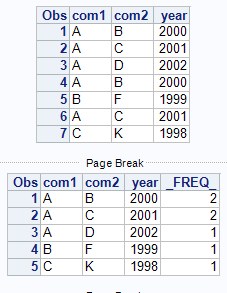- Home
- /
- Solutions
- /
- Data Management
- /
- Re: retaining unique combinations
- RSS Feed
- Mark Topic as New
- Mark Topic as Read
- Float this Topic for Current User
- Bookmark
- Subscribe
- Mute
- Printer Friendly Page
- Mark as New
- Bookmark
- Subscribe
- Mute
- RSS Feed
- Permalink
- Report Inappropriate Content
hi,
suppose that I have the following table:
| com1 | com2 | year |
|---|---|---|
| A | B | 2000 |
| A | C | 2001 |
| A | D | 2002 |
| B | A | 2000 |
| B | F | 1999 |
| C | A | 2001 |
| C | K | 1998 |
please note that the combinations A-B and A-C are present 2 times each, so what I would like to do is to include each combination only once and get the following table:
| com1 | com2 | year |
|---|---|---|
| A | B | 2000 |
| A | C | 2001 |
| A | D | 2002 |
| B | F | 1999 |
| C | K | 1998 |
thank you!
Accepted Solutions
- Mark as New
- Bookmark
- Subscribe
- Mute
- RSS Feed
- Permalink
- Report Inappropriate Content
input (com1 com2)(:$1.) year;
cards;
A B 2000
A C 2001
A D 2002
B A 2000
B F 1999
C A 2001
C K 1998
;;;;
run;
data scom;
set com;
call sortc(of com:);
run;
proc print;
run;
proc summary data=scom nway;
class com: year;
output out=unique(drop=_type_);
run;
proc print;
run;

- Mark as New
- Bookmark
- Subscribe
- Mute
- RSS Feed
- Permalink
- Report Inappropriate Content
The only way I know of is the manual way, which is probably what you are trying to avoid. The fastest way I know of is to insert all combinations into a "already used table", then do a lookup on it.
- Mark as New
- Bookmark
- Subscribe
- Mute
- RSS Feed
- Permalink
- Report Inappropriate Content
Switching data values around would work:
data halfway_there;
set have;
if com1 > com2 then do;
dummy = com1;
com1 = com2;
com2 = dummy;
end;
drop dummy;
run;
proc sort data=halfway_there out=want nodupkey;
by com1 com2;
run;
Possibly you want the final sort BY COM1 COM2 YEAR, but that is up to you.
I would bet the SQL programmers out there can do it in one step, along the lines of:
min(com1, com2) as com1, max(com1, com2) as com2
in combination with SELECT DISTINCT. I know the experiments I would try, but I'm not well versed enough to write out the code off the top of my head.
Good luck.
- Mark as New
- Bookmark
- Subscribe
- Mute
- RSS Feed
- Permalink
- Report Inappropriate Content
input (com1 com2)(:$1.) year;
cards;
A B 2000
A C 2001
A D 2002
B A 2000
B F 1999
C A 2001
C K 1998
;;;;
run;
data scom;
set com;
call sortc(of com:);
run;
proc print;
run;
proc summary data=scom nway;
class com: year;
output out=unique(drop=_type_);
run;
proc print;
run;

- Mark as New
- Bookmark
- Subscribe
- Mute
- RSS Feed
- Permalink
- Report Inappropriate Content
data want;
set have;
length string $200.;
retain string;
if index(string,catx('-',com1,com2))=0 then output;
string=catx(',',string,catx('-',com2,com1));
drop string;
run;
Need to connect to databases in SAS Viya? SAS’ David Ghan shows you two methods – via SAS/ACCESS LIBNAME and SAS Data Connector SASLIBS – in this video.
Find more tutorials on the SAS Users YouTube channel.



